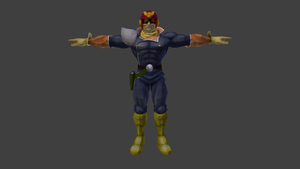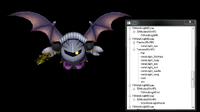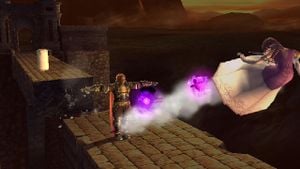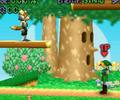T-pose
A T-pose, sometimes known as a bind pose or reference pose, is the default unanimated state of a model in 3D graphics. This pose is often with all of a model's various parts straightened out or flattened for ease of animation. For most characters, this results in a pose where the legs are straight and the arms are pointing sideways in a T shape.
Description
While a game is in development, character models are created and later textured; in this case, the bind pose acts as the best way to allow the programmer and/or artist to apply textures, as it allows the model's viewer to see most parts of the model's body with no obstruction.
As one may expect, the Super Smash Bros. series is no exception to this "rule" of development, and it is possible to view these bind poses in-game through certain methods and circumstances.
While the vast majority of characters use standard T-poses, certain characters have variants due to their body characteristics. Yoshi, for example, has his arms straight out in front of him instead of to the side (as does R.O.B.), while Ganondorf's armour in Melee forces him to take on an "A-pose" instead of a T-pose.
Characters that use model effects for facial expressions (such as Sonic or Kirby) can have their facial expressions look unusual when forced into their bind pose. Sonic's eyes, for instance, will always appear closed, while Kirby's mouth will be forced into its standard "o" shape.
In gameplay
Bind poses are generally only intended for game development and, in theory, they should never be seen in the actual gameplay of a final product. In Super Smash Bros. Brawl, however, some attacks will cause bind poses to appear for a single frame, such as Olimar's Pikmin Chain and Ganondorf's Beast Ganon; seeing these bind poses, however, requires almost perfect timing with the pause button, as well as external help by slowing the game's pace down considerably.
Among the most common ways to see bind poses, however, is through the use of moveset swap hacks. While most animations will operate as usual, if the two involved characters' special moves have an unequal number of animations (or simply have animations of different names), trying to use an animation that does not exist ends up forcing the character into their bind pose as a failsafe.
Hacks and glitches can also result in bind poses, often to act as a failsafe for animations that do not exist. Moveset swap hacks, for instance, are particularly notorious for featuring numerous bind poses, as bind poses are used when the two involved characters' special moves have an unequal number of frames. Furthermore, hacking ordinarily non-playable characters into brawls, such as Giga Bowser, will cause their losing poses to be the bind pose on the results screen, due to a lack of "applause" animations. In Smash 4, a glitch could also force bind poses to appear on the results screen if the Home button was pressed 1 frame before the beginning of the victory pose, as it could prevent the game from properly loading such poses; this glitch was later patched out in version 1.1.0.
An update later introduced a glitch that involves a Kirby with a hat. He can move around while in his T-pose position, and some attacks, like Link and Toon Link's arrows, can become glitchy.
Gallery
Two bind poses in SSB; note how Link is in the standard T-pose while Fox is not.
Mario, using Luigi's moveset through hacks, enters a bind pose due to a lack of suitable animations for Luigi Cyclone.
Mewtwo's bind pose in Super Smash Bros. for Wii U, shown due to an unknown glitch. Note the small shadowy aura around the body. Also shown is Ganondorf's bind pose.





